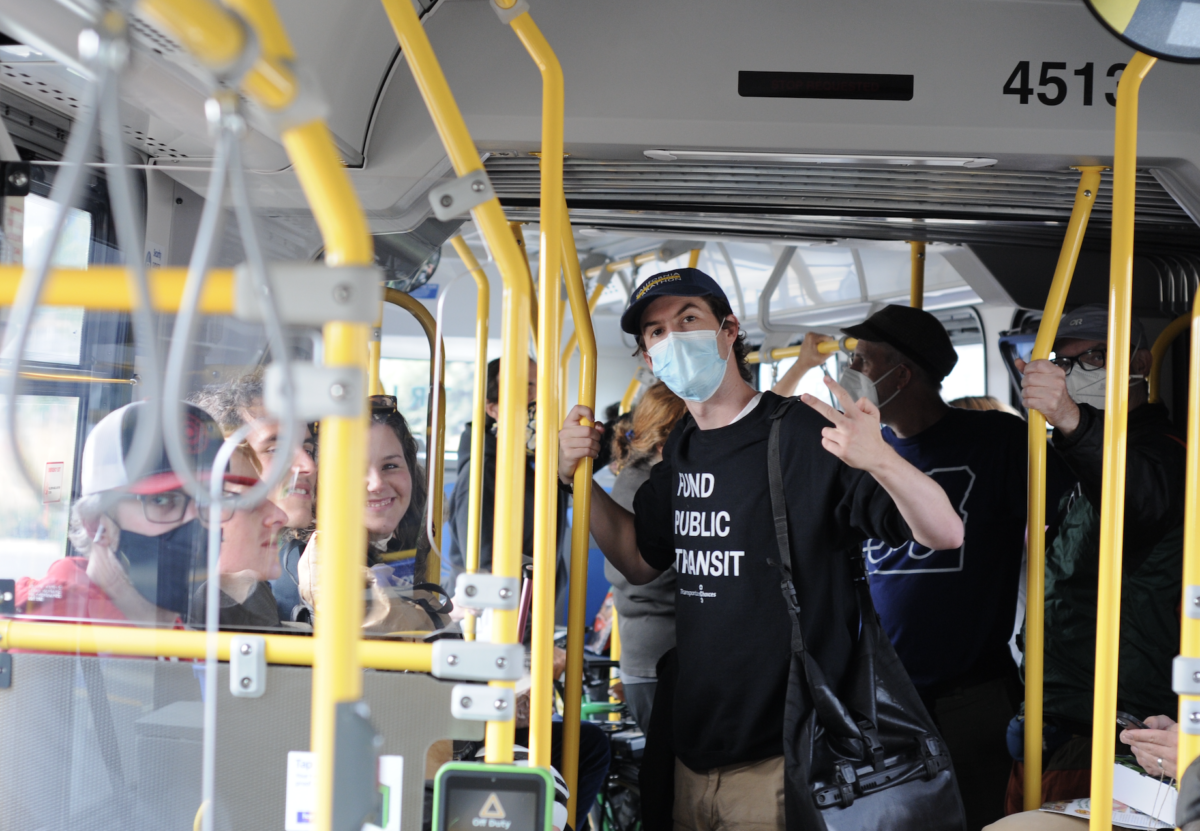
TriMet’s long-awaited Frequent Express (FX) line on SE Division Street is finally here. On Saturday, the transit agency celebrated the occasion with multiple events along the bus line, and eager transit lovers showed up in droves to ride the new “bendy buses” and mark the historic opening.
We took a more in-depth look at the new bus service recently, but I’ll outline a few highlights of the buses themselves.
You’ll notice the first one right away: the buses just look really cool. They’re 60-feet long and articulated (or “bendy”), with an accordion extender in the middle so they can fit more passengers. Articulated buses aren’t new by any means – they were included in TriMet’s fleet in the ’90s – but the Division FX buses’ bright green color gives them a modern, sleek look. The other cool thing about the bus design is that each bus has three sets of doors, which TriMet hopes will reduce delays at the bus stops because people will be able to get in and out quicker.
At least one bus was blocked by a freight train on Saturday, which really dampens the whole “express” idea of the bus service.
At the celebration on Saturday, people with bikes were very eager to test out the FX line’s internal bike racks, which replace the front racks that you’ll see on other TriMet buses. There are two racks on the ground of each bus for people to store their bikes, and there’s no major lifting required to get them into place. Though I think the bus drivers may be a little stricter in the future, operators let us take more than two bikes on the bus on Saturday (it was a special occasion!), which was a good way to test out how crowded these vehicles can get. The verdict? Even with three or four bikes, there was plenty of room to get around. (Check out our how-to guide for some tips for bringing your bike on the new Division buses.)
The other big selling point of the FX bus system is its speed and frequency. The new bus stops along the line were built to speed up passenger loading times, and the buses are set to run every 12 minutes as opposed to the 15 minute headways on other popular TriMet routes. On Saturday, however, it seemed like they were figuring some kinks out. The buses took a bit longer than 12 minutes to show up, and there were delays at the stops. An operator on the bus line I was on acknowledged the problems, saying “we’ll get better the more we do it!” which garnered a round of applause from passengers, most of whom were in no hurry and just came to enjoy the event.
One problem that might be out of TriMet control: the rail crossings in inner southeast that intersect with the new bus line. At least one bus was blocked by a freight train on Saturday, which really dampens the whole “express” idea of the bus service. The city is making some moves to try to fix this problem, but it seems like it will present some unfortunate impediments for the foreseeable future.
Beyond getting to check out the new infrastructure, my main takeaway from Saturday’s event was how cool it is that so many people are willing to come out to celebrate a new bus line. And with all the stops TriMet pulled out, it’s clear they’re aware they have some transportation nerds in their audience. (Those who were willing to travel to Gresham had the chance to get a Division FX bus LEGO set – need I say more?)
The gathering at Division and 82nd Ave featured an Asian food market and a traditional Japanese drumming show from Portland Taiko, a Portland Chinese Women’s Group fashion show and a performance from Mexican youth dance group Ballet Paplotl, among other acts intended to showcase east Portland’s cultural diversity. I think this was a perfect encapsulation of how good public transit can bring communities together and truly connect people from all over the city.
It will be interesting to see how people respond to the new FX service. Overall TriMet ridership is just starting to recover from the big dip seen during the pandemic, but the agency has fallen on more hard times with its operator shortage. With luck (and hard work on TriMet’s part), this new line can herald a public transit renaissance in Portland.
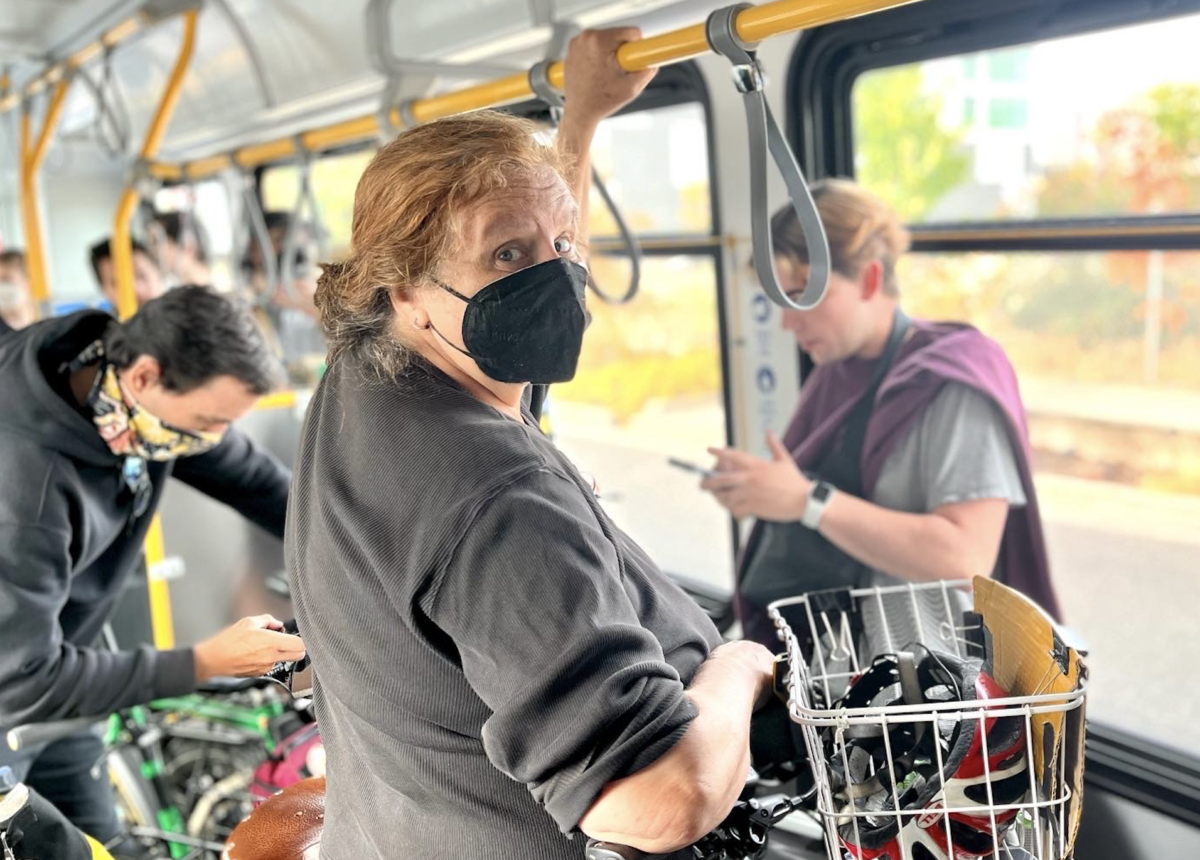

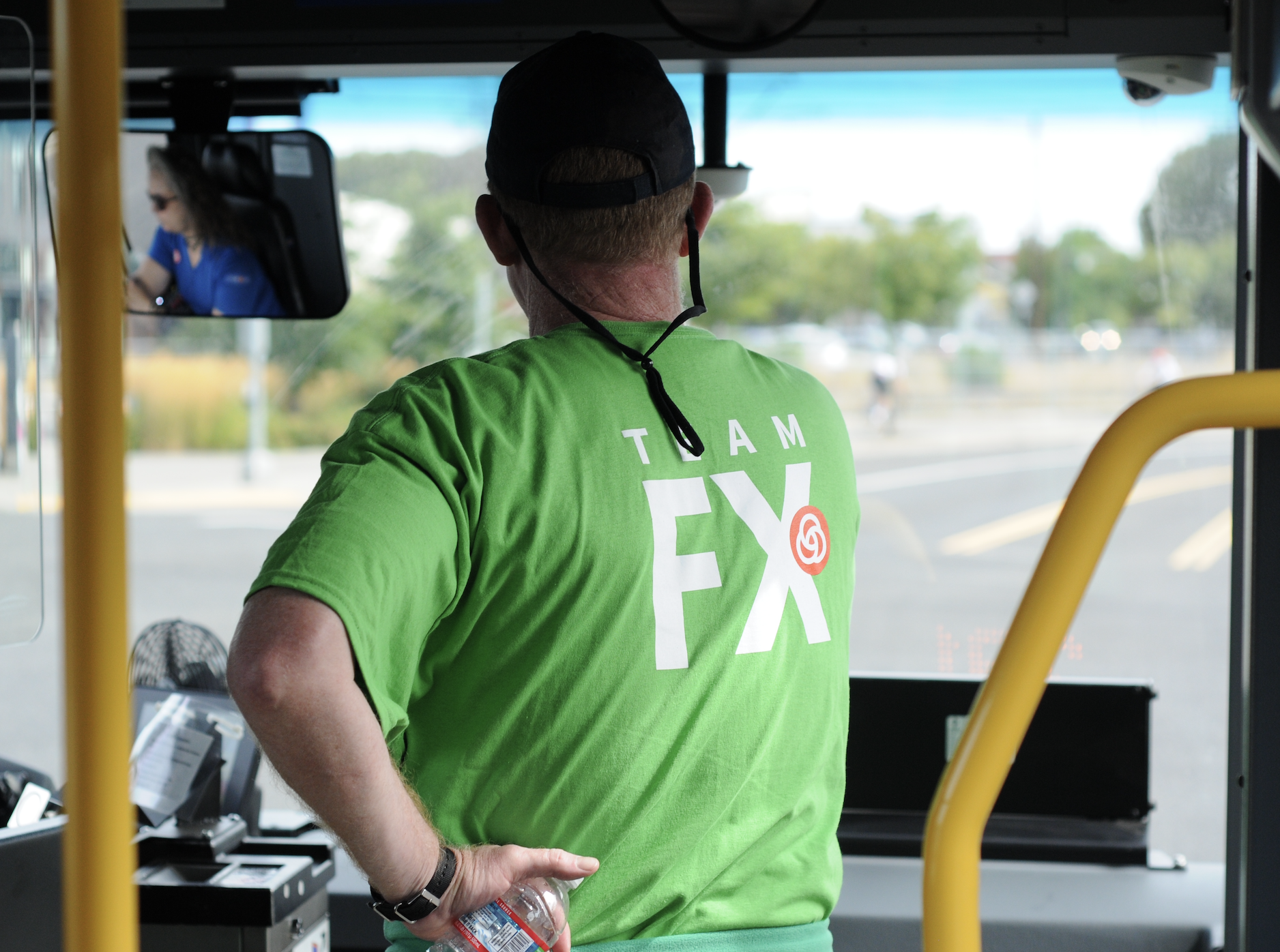

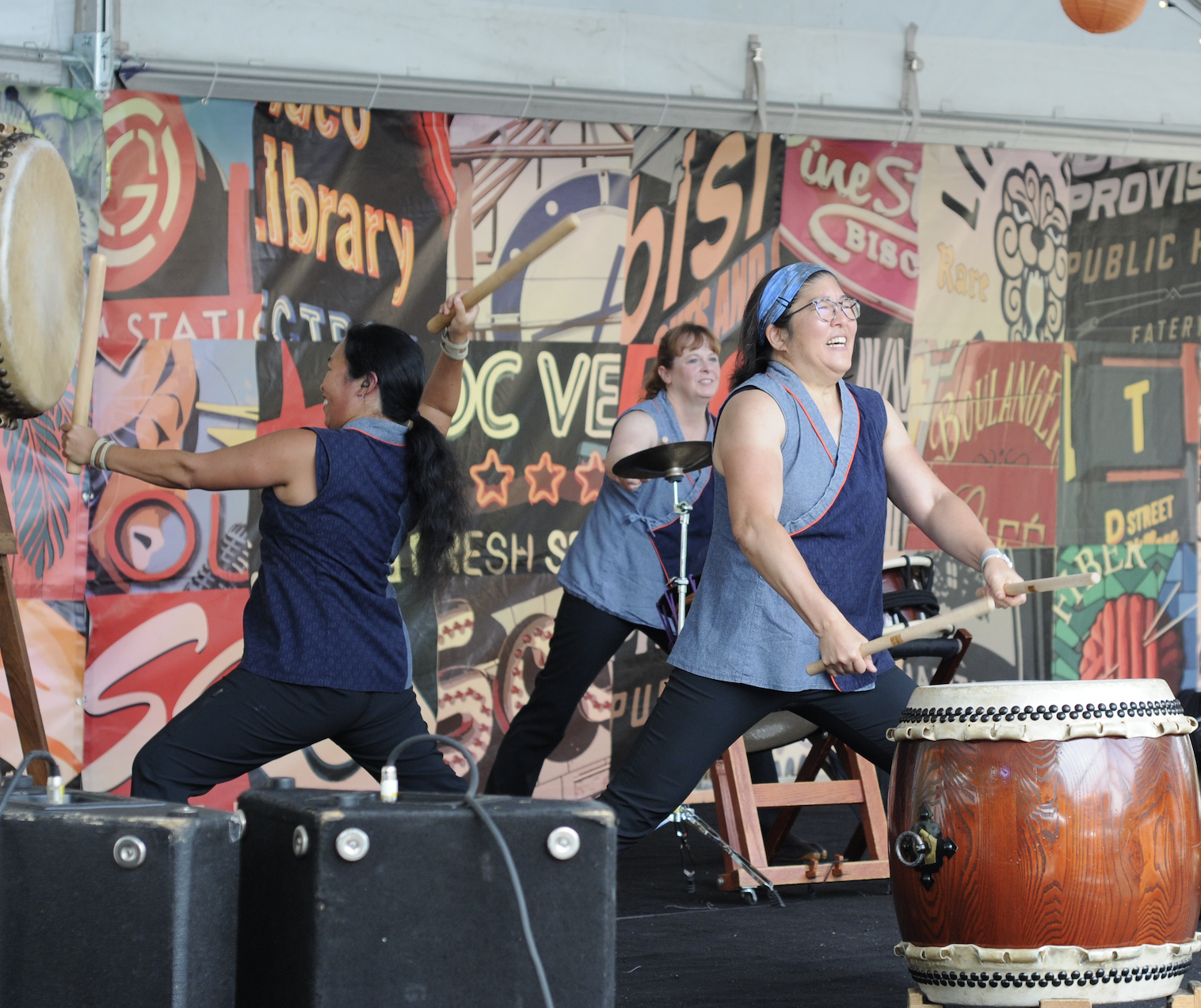
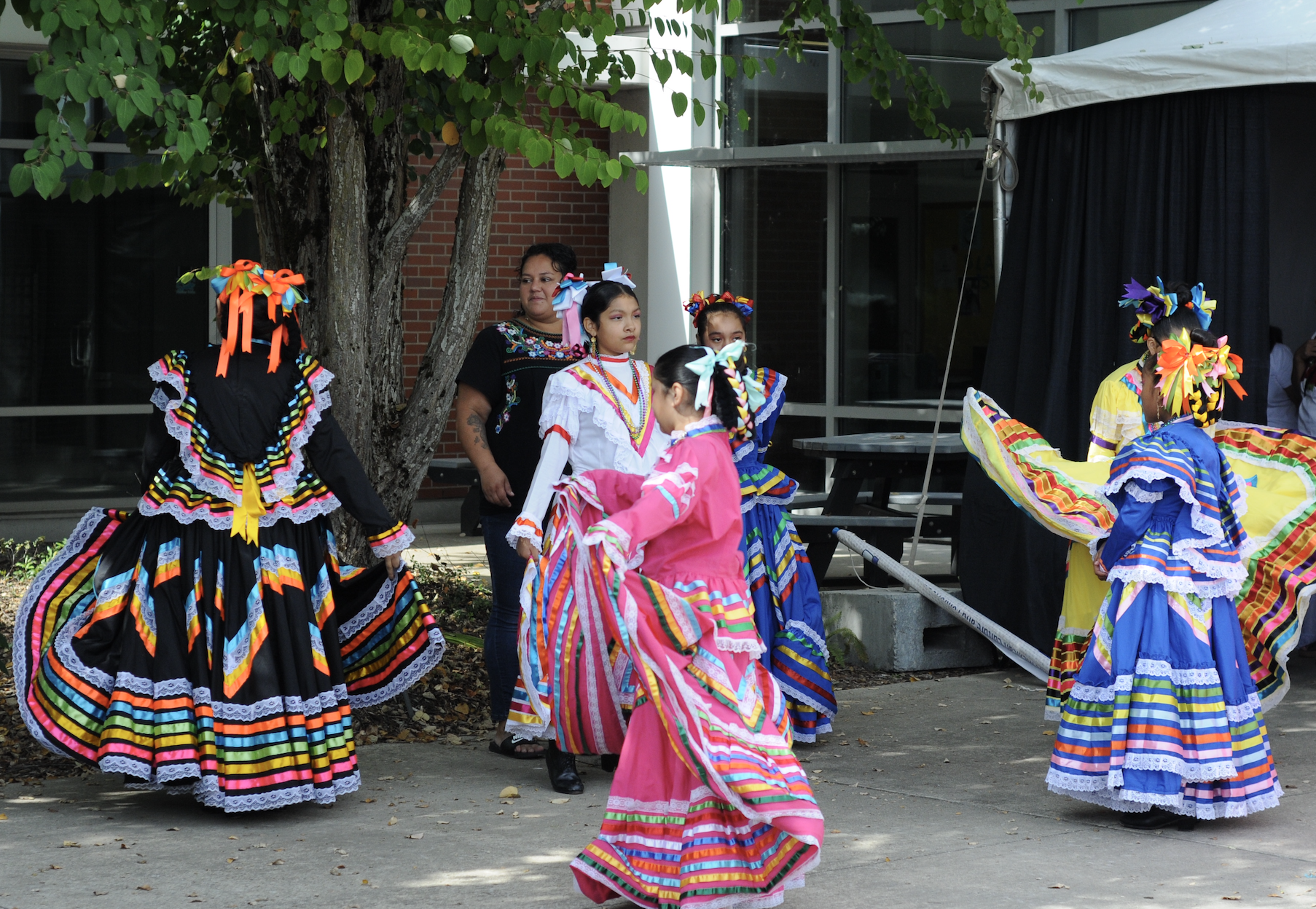


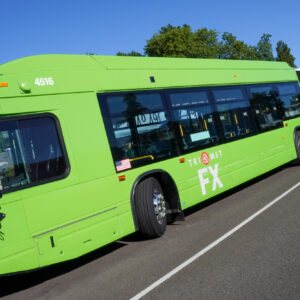
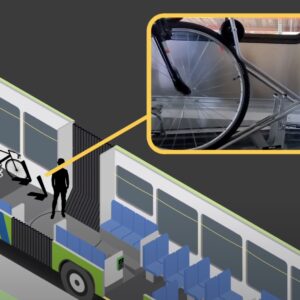
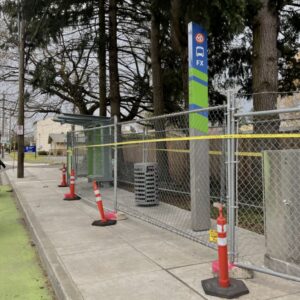
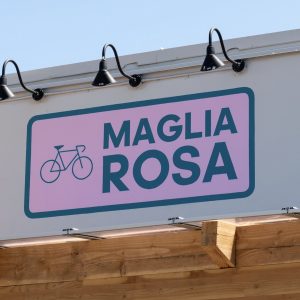
Thanks for reading.
BikePortland has served this community with independent community journalism since 2005. We rely on subscriptions from readers like you to survive. Your financial support is vital in keeping this valuable resource alive and well.
Please subscribe today to strengthen and expand our work.
I noticed that Trimet (or PBOT?) removed the bike parking at 34th and Division to make way for the new stop there. No replacement or alternative staples at that intersection.
Anyone else notice racks that were displaced by this project?
I love the idea of this line… but what on earth was TriMet thinking with the routing across the rail line? I’m never going to take a bus if it’s going to be unreliable and blocked ¼ of the time. Good luck explaining being late all the time to an employer.
I’d much rather see the bus routed across the Hawthorne on the 2’s old route (or rerouting the bus to Hawthorne entirely west of 50th) rather than TriMet feeling the need to show off their shiny “new” Tilikum bridge while completely destroying the route’s reliability. Until then, even with the detour they give above, it’s simply going to be too unreliable to move the ridership needle.
This is purely speculation on my part, but I wonder if they went with the current routing to tick certain boxes in order to be more competitive for federal grants?
The old Line 2 route didn’t serve PSU (Higher Education + Employment), OHSU (Healthcare + Employment), or OMSI (Cultural Institution).
I could be completely off-base, but remember that they were applying for funding during the Trump administration & a republican controlled congress when there wasn’t as much federal funding to go around.
This is their official reasoning: https://trimet.org/division/pdf/DTP_River_Crossing.pdf
I’d rate the analysis there as pretty weak. <1 and >3 minute buckets are just the entirely wrong way to look at it (not to mention “rail crossing events” is a bit nebulous – do these figures include MAX crossing, or just freight rail?). Total time the crossing is closed is probably a more pertinent question – if 1% of rail crossings are >3 minutes, but they are an hour long that’s much different than if 5% of rail crossing are >3 minutes, but they are 8 minutes long.
Maybe they looked at it more closely than they are showing in the document there, but it just reeks of a decision being made without actual care of operational concerns.
That analysis is hugely flawed. It’s not the quick trains that are the problem, it’s the very slow or even stopped double-length freight trains that are the issue. When these events occur, they cause extreme delays in both directions. It throws off the planned runs so badly that the schedule cannot be recovered. Their analysis glosses over this by noting “5-9% are over 3 minutes”. Yes, but how many are over 30 minutes? Anything that long is insanely disruptive and completely unacceptable on any transit line, let alone a “rapid” one.
I’m coming back to this late, but I believe things got worse after their analysis: https://www.southeastexaminer.com/2021/12/train-blockages-frustrate-se/
Does anyone know if the streetcar bridge from MLK over the RR tracks was ever considered? The bridge would have to be modified to accept buses, but buses and streetcar currently share lanes I think. I think the route would have to be DIvision-6th-Mill wb. Could be structural problems adding the additional pavement to the bridge, and maybe new signals, but avoiding the train delays seems worth a lot of money.
On Friday, my coworker witnessed a very loud “fanfare” indeed when one of the brand new buses on Division sheared the door off the parked car of a driver who opened it without looking.
Silver lining though: This is the best possible way for the careless driver to learn to look before opening their door. A bus doesn’t say “ouch” but a cyclist could have been seriously injured.
A public transit official in another city once told me that there is an obscure FTA rule (Federal Transit Administration – a division of USDOT) that all publicly-subsidized buses must allow bicycles directly on board, whether they are designed to accommodate them or not, and theoretically there is no legal limit to how many. Nearly all buses are federally subsidized, including city buses, Bolt, Greyhound, and so on. Most bus services responded to this rule by proactively adding external racks to the front of the bus, with the hope and expectation that the public would simply never bother to look up this rule – and in fact I haven’t done so myself.
If anyone wants to sell a Trimet FX lego set, please email me!
I rode the FX on Sunday from downtown to 12th and Division (rather than my usual MAX ride) to see what it was like. It took 40 minutes largely because of a freight train stopping at the crossing. TriMet would rather serve the shiny new big ticket items than run an actual reliable service. Choosing to run an express service over the only bridge that doesn’t have a viaduct over the UPRR tracks is just delusional.
The stated reasoning (https://trimet.org/division/pdf/DTP_River_Crossing.pdf) of “providing a link between Mount Hood Community College, Portland Community College, PSU and OHSU” is a little strange – it seems unlikely that trips between MHCC and PSU are really huge drivers of ridership. Claiming that the Hawthorne Bridge being “close to vehicle capacity” and “congestion concerns” because of that is just really poor reasoning in my opinion. The solution to that is a dedicated bus lane, not totally re-routing a perfectly good reliable service to a longer, less reliable route. TriMet has a long history of fully capitulating to cars – just look at what they did to the downtown transit mall in 2009. Adding a full vehicle through lane and street parking at the behest of a poll of business owners who wanted street parking in front of their stores. (https://www.bizjournals.com/portland/stories/2002/11/11/story5.html)
TriMet would rather operate as a developer/speculation agency than run a bus service that people can actually rely on – and it really hurts the city and region.
I rode this on Saturday, and got to experience both the big positives and big negatives of this line. I hopped off the 75 on 39th and was able to immediately walk on the back door of a waiting FX at Division. We blasted down to OMSI with signal priority and no stops for trains. It really did feel faster than the 2.
However, on the way back, there was an issue with the tourist railroad leaving from the Oregon Rail Heritage Center. The train had left about 5 minutes previous, but the crossing signal was still on, shutting down all bus and MX both east/west at Water Ave. This went on for at least 20+ minutes, so I just snagged a Biketown and rode back. This kind of disruption can happen both at Water and then again at 8th. It’s unacceptable for a “rapid” service like this.
I share others’ concerns with TriMet’s boneheaded decision to run the FX2 over the railroad tracks.
But something I did not quite realize was how many stops — bus stops — TriMet removed from the original #2 line in order to get speedier service on the FX2. In inner SE it’s not as easy to see; many of the stops just switched sides of roads, and when a stop was removed there was usually another a couple of blocks away.
But in outer SE, dozens of stops were removed, and there are places where there are now 10-block gaps between some stops. (I literally cannot find a list of closed stops anywhere on TriMet’s site or elsewhere online, but you can see a list on physical signs at any of the old #2 stops, or you can compare the old #2 stops with the new FX2 stops.)
I know the FX went through several rounds of proposals and redesigns, but until quite recently I had thought it was going to supplement the 2 line — in other words that the 2 line would run as usual, making all the original “local” stops, and then FX2 would run express, only making major stops. Totally possible that was just something I made up in my head, but I wonder if anyone else had that impression.
And while I’ll personally benefit from the FX2 being on Division, I’m still confused as to why it’s not partly/completely Powell. An FX on Powell could easily do the local/express option since there are two lanes each way, and it would have no at-grade railroad crossings. I think “moving forward” by closing stops is fundamentally the wrong approach.
I think it’s okay that they closed some stops, although maybe 10 block stop spacing is a bit too much. I agree Powell makes more sense, but I think the operational benefits are probably much smaller. The 2 was probably the route upgrade that offered the most benefit relative to the original service – Division’s wacky signals and smaller ROW makes it much less reliable, so signal priority makes a gigantic difference. I think the 9 on Powell would need dedicated lanes to see a similar amount of relative operational benefit – which it should get anyways! – but is probably way harder to accomplish with ODOT having ownership over the road
I’m still not clear on how busses are supossed to reduce traffic when the stops are designed without a place for the bus to pull off to the side so other road users can get past them? Example; Belmont Westbound at 34th, the bus used to pull off to the side in front of Hodas, now they made it stop in front of the Belmont Inn after adding a huge chunk of concrete that protrudes into the street, blocking all other road users and often using up the entire stop light cycle. It looks like many of the new stops on Division are designed the same way.
Chris,
The idea is to make driving so miserable and slow and inconvenient that when people have a choice to make about how to get around, as many of them as possible choose to not use their cars. A lot of this stuff is about competition. PBOT is trying to make buses compete better with cars. By not having to pull out of a traffic lane to serve a bus stop, they can make those stops quicker – car traffic behind them be damned! Awesome right?!
Not that awesome, it blocks bikes, not just cars (the Belmont one).
City planers are out of touch with what’s going on.